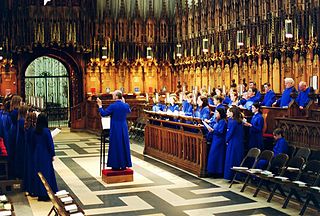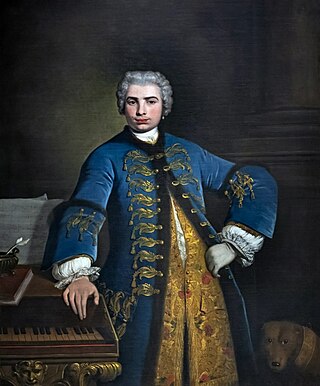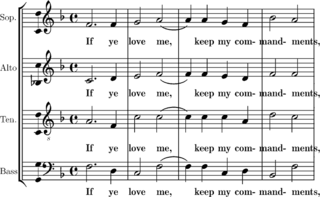Related Research Articles

A choir is a musical ensemble of singers. Choral music, in turn, is the music written specifically for such an ensemble to perform. Choirs may perform music from the classical music repertoire, which spans from the medieval era to the present, or popular music repertoire. Most choirs are led by a conductor, who leads the performances with arm, hand, and facial gestures.

A clef is a musical symbol used to indicate which notes are represented by the lines and spaces on a musical stave. Placing a clef on a stave assigns a particular pitch to one of the five lines, which defines the pitches on the remaining lines and spaces.
A countertenor (also contra tenor) is a type of classical male singing voice whose vocal range is equivalent to that of the female contralto or mezzo-soprano voice types, generally extending from around G3 to D5 or E5, although a sopranist (a specific kind of countertenor) may match the soprano's range of around C4 to C6. Countertenors often have tenor or baritone chest voices, but sing in falsetto or head voice much more often than they do in their chest voice.
The musical term alto, meaning "high" in Italian, historically refers to the contrapuntal part higher than the tenor and its associated vocal range. In 4-part voice leading alto is the second-highest part, sung in choruses by either low women's or high men's voices. In vocal classification these are usually called contralto and male alto or countertenor.
A tenor is a type of classical male singing voice whose vocal range lies between the countertenor and baritone voice types. It is the highest male chest voice type. The tenor's vocal range extends up to C5. The low extreme for tenors is widely defined to be B2, though some roles include an A♭2 (two A♭s below middle C). At the highest extreme, some tenors can sing up to the second F above middle C (F5). The tenor voice type is generally divided into the leggero tenor, lyric tenor, spinto tenor, dramatic tenor, heldentenor, and tenor buffo or spieltenor.
A ledger line or leger line is used in Western musical notation to notate pitches above or below the lines and spaces of the regular musical staff. A line slightly longer than the note head is drawn parallel to the staff, above or below, spaced at the same distance as the lines within the staff.

Vespro della Beata Vergine, SV 206, is a musical setting by Claudio Monteverdi of the evening vespers on Marian feasts, scored for soloists, choirs, and orchestra. It is an ambitious work in scope and in its variety of style and scoring, and has a duration of around 90 minutes. Published in Venice as Sanctissimae Virgini Missa senis vocibus ac Vesperae pluribus decantandae, cum nonnullis sacris concentibus, ad Sacella sive Principum Cubicula accommodata, it is sometimes called Monteverdi's Vespers of 1610.

A madrigal is a form of secular vocal music most typical of the Renaissance and early Baroque (1600–1750) periods, although revisited by some later European composers. The polyphonic madrigal is unaccompanied, and the number of voices varies from two to eight, but usually features three to six voices, whilst the metre of the madrigal varies between two or three tercets, followed by one or two couplets. Unlike the verse-repeating strophic forms sung to the same music, most madrigals are through-composed, featuring different music for each stanza of lyrics, whereby the composer expresses the emotions contained in each line and in single words of the poem being sung.

Coloratura is an elaborate melody with runs, trills, wide leaps, or similar virtuoso-like material, or a passage of such music. Operatic roles in which such music plays a prominent part, and singers of these roles, are also called coloratura. Its instrumental equivalent is ornamentation.

In music, homophony is a texture in which a primary part is supported by one or more additional strands that provide the harmony. One melody predominates while the other parts play either single notes or an elaborate accompaniment. This differentiation of roles contrasts with equal-voice polyphony and monophony. Historically, homophony and its differentiated roles for parts emerged in tandem with tonality, which gave distinct harmonic functions to the soprano, bass and inner voices.
A descant, discant, or discantus is any of several different things in music, depending on the period in question; etymologically, the word means a voice (cantus) above or removed from others. The Harvard Dictionary of Music states:
Anglicized form of L. discantus and a variant of discant. Throughout the Middle Ages the term was used indiscriminately with other terms, such as descant. In the 17th century it took on special connotations in instrumental practice.

The cantu a tenòre is a style of polyphonic folk singing characteristic of the island of Sardinia, particularly the region of Barbagia, though some other Sardinian sub-regions bear examples of such tradition.
Falsobordone is a style of recitation found in music from the 15th to the 18th centuries. Most often associated with the harmonization of Gregorian psalm tones, it is based on root position triads and is first known to have appeared in southern Europe in the 1480s.

A part generally refers to a single strand or melody or harmony of music within a larger ensemble or a polyphonic musical composition. There are several senses in which the word is often used:

The Tenores di Bitti are a traditional folk music group from Bitti, Sardinia who employ a polyphonic vocal style, often described as a type of overtone singing, whose oral tradition dates back to 3000 BC.
Blue Heron, directed by Scott Metcalfe, is a professional vocal ensemble based in the Boston area. The ensemble presents an annual concert series in Cambridge, Massachusetts, and performs throughout New England as well as touring the US; it made its European debut in the United Kingdom in 2017.
Quintus is a Latin praenomen, or personal name, which was common throughout all periods of Roman history. It was used by both patrician and plebeian families, and gave rise to the patronymic gentes Quinctia and Quinctilia. The feminine form is Quinta. The name was regularly abbreviated Q.

Drexel 4180–4185 is a set of six manuscript partbooks copied in Gloucester, England, containing primarily vocal music dating from approximately 1615-1625. Considered one of the most important sources for seventeenth century English secular song, the repertoire included represents a mixture of sacred and secular music, attesting to the partbooks' use for entertainment and pleasure, rather than exclusively for liturgical use.
The Forrest-Heyther partbooks are a set of six manuscript partbooks copied in England in the sixteenth century. They are an important source of polyphonic Mass Ordinary settings by composers from the reign of Henry VIII, including John Taverner and Robert Fayrfax.
The Peterhouse partbooks are a collection of English partbooks dating from the sixteenth and seventeenth centuries. They are named "Peterhouse" after Peterhouse in Cambridge, where the books were kept for some time, and are now preserved in the Cambridge University Library. They are handwritten manuscripts, all written on paper. At some point in the mid-eighteenth century, the books were rebound, although the foliation and indices remained unchanged.
References
- ↑ Randel, Don Michael (1999). The Harvard concise dictionary of music and musicians. Harvard University Press. p. 541. ISBN 0674000846.
- ↑ Paul Terry, David Bowman (2006). A student's guide to A2 music: for the Edexcel specification 2006-2007. Rhinegold Publishing Ltd. p. 118. ISBN 1904226876.
- ↑ Cole, Richard. "Quintus". Virginia Tech Multimedia Music Dictionary. Virginia Polytechnic Institute and State University. Archived from the original on October 22, 2014. Retrieved 9 March 2012.
- ↑ Artopium. "Vagans". Music Term Index. Artopium.com. Retrieved 10 March 2012.